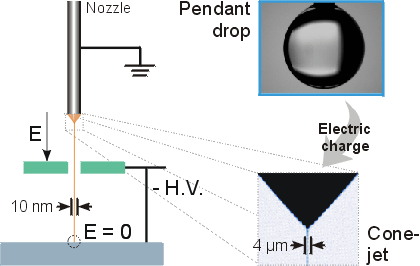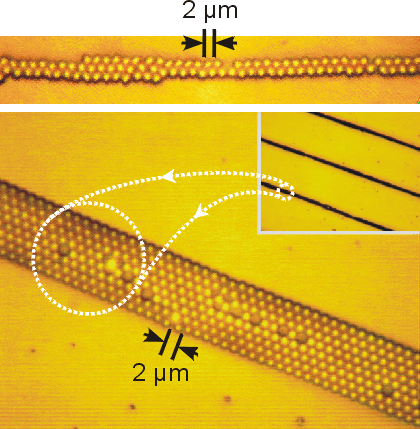Research: Electrohydrodynamic Printing (EHDP)
Sibel Korkut
Advisors: Dudley A. Saville and Ilhan A. Aksay
The ability to decorate surfaces with micron or nanometer-scale features is of increasing importance for various applications, such as photonic materials [1,2], high-density magnetic data storage devices [3], microchip reactors [4] and biosensors [5]. One method of preparing such structures is through the hierarchical assembly of colloidal particles [6-10]. Colloidal particles are used since they can be synthesized in a variety of shapes and sizes from different precursor materials. Micropatterned colloidal assemblies have been produced with lithographically patterned electrodes [5,11] or micromolds [12,13]. An alternative approach is the category of direct writing techniques where patterns are formed by direct transfer of precursor materials without using masks or molds. Printed circuit board [14], transistor circuits [15], array-based nanostructures [16] and biosensors [17] have been made.
We have been developing a direct printing method which permits rapid prototyping of microstructures/nanostructures with an exquisite degree of external control over the internal structure of patterned materials. Our method employs electrohydrodynamic forces to form a thin jet (< 1 Ám) containing colloidal particles from a relatively large (>50 Ám) orifice as shown in the following schematic.

Schematic of EHDP. The suspension is first deployed by field-assisted flow in the form of a thin continuous filament. Rapid evaporation suppresses the Rayleigh instability and the feature shape is fixed by radiation or heating.
This jet is then deployed on a surface to produce thin linear arrays. Our approach offers a major advantage in eliminating nozzle clogging when manipulating highly-loaded suspension flow. Further, it enables the "decoration" and "patterning" of layered systems at small length scales (< 1 Ám) with homogeneous fluids and suspensions followed by polymerization or solidification. To understand the electrohydrodynamic process, we directly measure jet size and its dependence on flow rate to map regimes of cone-jet behavior. In this process, we have discovered a new regime where the current shows an inverse dependence with increasing flow rate [18]. This behavior is opposite to that predicted by current scaling laws where current would increase with liquid flow rates [19].
We have shown that colloidal suspensions also exhibit the cone-jet transition under the action of an applied electric field [18]. However, compared with its liquid counterpart, colloidal jets are even more difficult to stabilize due to the increased charge density and the presence of inhomogenities. Various strategies including printhead design are exploited to stabilize colloidal jet. Lines with colloids as small as a few microns have been patterned [18] which surpasses the best available ink jet resolution, as shown in the following figure.

Lines formed from suspensions of 2Ám polystyrene spheres: (top) 2-particle diameter thickness and (bottom) 8-particle diameter thickness.
For more information on this research topic, please contact Sibel Korkut. Additional information concerning the CML can be found on our website.
References
1. S.Y. Lin, E. Chow, V. Hietala, P.R. Villeneuve, J.D. Joannopoulos, Science 282 (1998).
2. O. Painter, et al. Science 284 (1999).
3. C. Haginoya, M. Ishibashi, K. Koike, Appl. Phys. Lett. 71 (1997).
4. H. Gau, S. Herminghaus, P. Lenz, R. Lipowsky, Science 283 (1999).
5. O.D. Velev, E.W. Kaler, Langmuir 15 (1999).
6. R.P. Andres, et al., J. Mater. Res. 4 (1989).
7. I.I. Tarhan, G.H. Watson, Phys. Rev. Lett. 76 (1996).
8. J. Wijnhoven, W.L. Vos, Science 281 (1998).
9. S.A. Asher, J. Holtz, J. Weissman, G.S. Pan, MRS Bull. 23 (1998).
10. J.F. Bertone, P. Jiang, K.S. Hwang, D.M. Mittleman, V.L Colvin, Phys. Rev. Lett. 83 (1999).
11. S.R. Yeh, M. Seul, B.I. Shraiman, Nature 386 (1997).
12. E. Kim, Y.N. Xia, G.M. Whitesides, Adv. Mater. 8 (1996).
13. Y. Huang, X.F. Duan, Q.Q. Wei, C.M. Lieber, Science 291 (2001).
14. T. Cuk, S.M. Troian, C.M. Hong, S. Wagner, Appl. Phys. Lett. 77 (2000).
15. H. Sirringhaus, et al., Science 290 (2000).
16. H.Y. Fan, et al., Nature 405 (2000).
17. A. Roda, M. Guardigli, C. Russo, P. Pasini, M. Baraldini, Biotechniques 28 (2000).
18. Hak Fei Poon, PhD Thesis, Princeton University, Chemical Engineering (2002).
19. A.M. GananCalvo, J. Fluid Mech. 335 (1997).
![]()
![]()
![]() © 2004 Princeton University, Ceramic Materials Laboratory.All Rights Reserved.
© 2004 Princeton University, Ceramic Materials Laboratory.All Rights Reserved.


